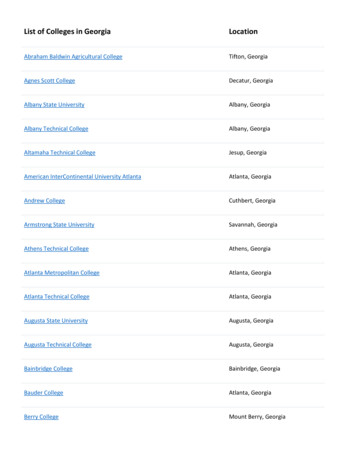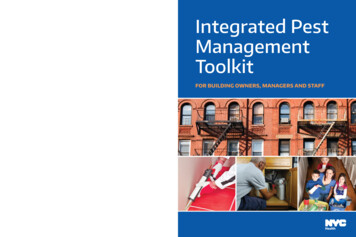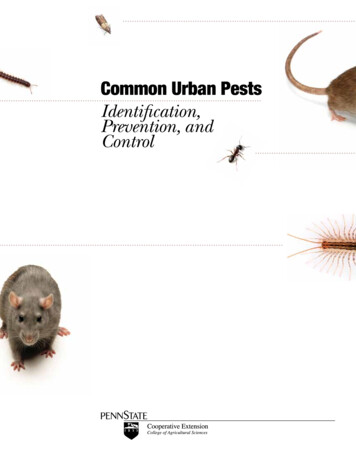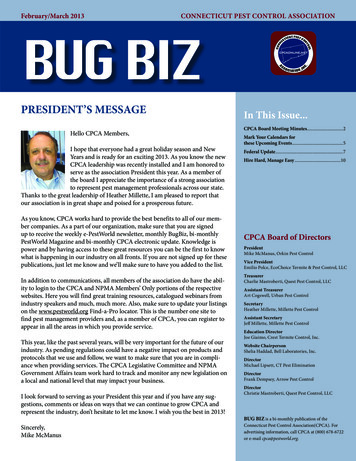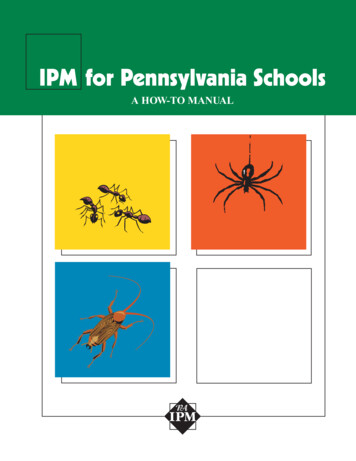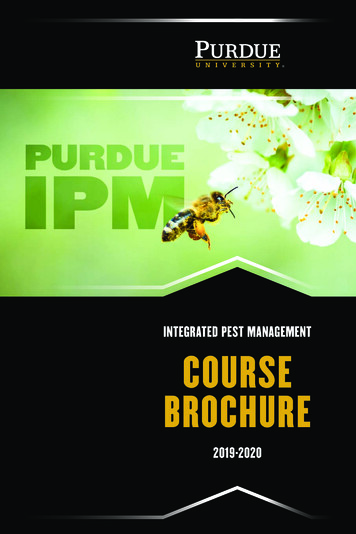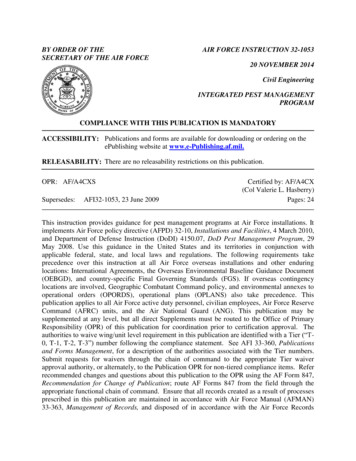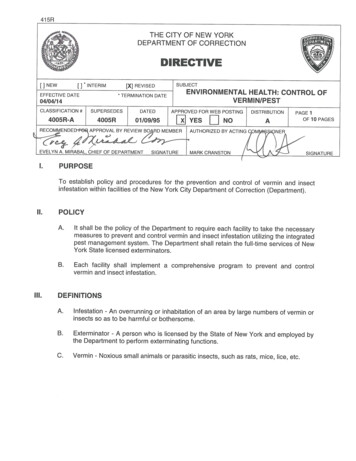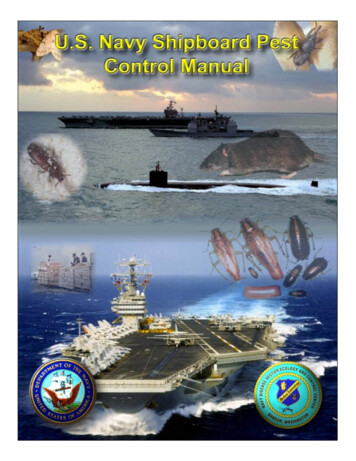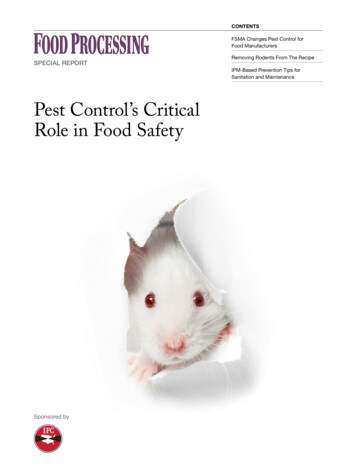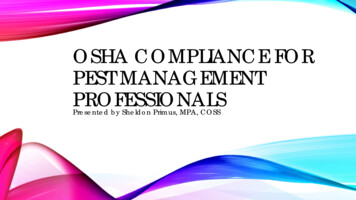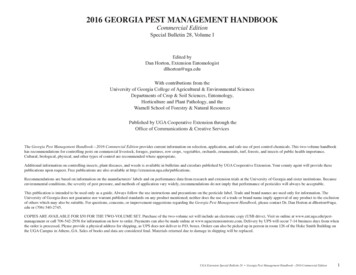
Transcription
2016 GEORGIA PEST MANAGEMENT HANDBOOKCommercial EditionSpecial Bulletin 28, Volume IEdited byDan Horton, Extension Entomologistdlhorton@uga.eduWith contributions from theUniversity of Georgia College of Agricultural & Environmental SciencesDepartments of Crop & Soil Sciences, Entomology,Horticulture and Plant Pathology, and theWarnell School of Forestry & Natural ResourcesPublished by UGA Cooperative Extension through theOffice of Communications & Creative ServicesThe Georgia Pest Management Handbook—2016 Commercial Edition provides current information on selection, application, and safe use of pest control chemicals. This two-volume handbookhas recommendations for controlling pests on commercial livestock, forages, pastures, row crops, vegetables, orchards, ornamentals, turf, forests, and insects of public health importance.Cultural, biological, physical, and other types of control are recommended where appropriate.Additional information on controlling insects, plant diseases, and weeds is available in bulletins and circulars published by UGA Cooperative Extension. Your county agent will provide thesepublications upon request. Free publications are also available at ons are based on information on the manufacturers’ labels and on performance data from research and extension trials at the University of Georgia and sister institutions. Becauseenvironmental conditions, the severity of pest pressure, and methods of application vary widely, recommendations do not imply that performance of pesticides will always be acceptable.This publication is intended to be used only as a guide. Always follow the use instructions and precautions on the pesticide label. Trade and brand names are used only for information. TheUniversity of Georgia does not guarantee nor warrant published standards on any product mentioned; neither does the use of a trade or brand name imply approval of any product to the exclusionof others which may also be suitable. For questions, concerns, or improvement suggestions regarding the Georgia Pest Management Handbook, please contact Dr. Dan Horton at dlhorton@uga.edu or (706) 540-2745.COPIES ARE AVAILABLE FOR 50 FOR THE TWO-VOLUME SET. Purchase of the two-volume set will include an electronic copy (USB drive). Visit us online at www.ent.uga.edu/pestmanagement or call 706-542-2956 for information on how to order. Payments can also be made online at www.ugaextensionstore.com. Delivery by UPS will occur 7-14 business days from whenthe order is processed. Please provide a physical address for shipping, as UPS does not deliver to P.O. boxes. Orders can also be picked up in person in room 126 of the Hoke Smith Building onthe UGA Campus in Athens, GA. Sales of books and data are considered final. Materials returned due to damage in shipping will be replaced.UGA Extension Special Bulletin 28 Georgia Pest Management Handbook—2016 Commercial Edition1
CONTENTSUSE PESTICIDES SAFELY.6PESTICIDE EMERGENCIES.9IMPORTANT TELEPHONE NUMBERS.12ABBREVIATIONS AND EQUIVALENTS.14SUBMITTING SPECIMENS FOR IDENTIFICATION: COLLECTION, PREPARATION AND SHIPMENTInsects — Dan Horton.16Guidelines for Submitting Samples Using the Distance Diagnostics Through Digital Imaging (DDDI) System — Elizabeth Little.17How To Submit Samples for Homeowner Plant Disease Diagnosis — Elizabeth Little.18Nematodes — Bob Kemerait.20Weeds — Patrick E. McCullough.21Fish — Gary J. Burtle.22Vertebrates — Mike Mengak.24PESTICIDE SAFETY AND OTHER PESTICIDE INFORMATIONPesticide Legislation, Regulations and Certifications — Milton Taylor.26Pesticide Rate and Dosage Calculations — Milton Taylor.32Calibration Method for Hydraulic Boom and Band Sprayers and Other Liquid Applicators — Gary L. Hawkins and Glen C. Rains.36Calibration Method for Boomless Broadcast Sprayers — Gary L. Hawkins and Glen C. Rains.39Calibration Method for Granular Applications — Gary L. Hawkins and Glen C. Rains.41Calibration of Backpack Sprayers 1000 Sq Ft Method — Gary L. Hawkins and Glen C. Rains .44Calibrating Turfgrass Sprayers (Gallons Per 1000 Sq Ft) — Gary L. Hawkins and Glen C. Rains.46Hand Sprayer Calibration for Ornamental and Turf — Gary L. Hawkins and Glen C. Rains.47Airblast Sprayer Calibration: Orchard and Vineyard— Gary L. Hawkins and Glen C. Rains.48Pesticide Resistance Management — Milton Taylor.49Protect Honey Bees From Pesticides — Keith S. Delaplane.49CORNCorn Insect Control — David Buntin and John All.51Insecticide Use Restrictions for Field Corn — David Buntin and John All.60Corn Nematode Control — Bob Kemerait. 61Field Corn Disease Control — Bob Kemerait.62Field Corn Weed Control — Eric P. Prostko.65Weed Response To Herbicides Used In Field Corn — Eric P. Prostko.77Weed and Cover Crop Response To Burndown Herbicides Used In Conservation Tillage Field Corn Production Systems In Georgia—Eric P. Prostko.85Herbicide Programs For Managing Glyphosate and Als-Resistant Palmer Amaranth In Field Corn.86Herbicide Programs For Managing Glyphosate, Als, and Atrazine Resistant Palmer Amaranth In Field Corn.87Post-Harvest (Corn) Management of Palmer Amaranth.872UGA Extension Special Bulletin 28 Georgia Pest Management Handbook—2016 Commercial Edition
CONTENTSCOTTONCotton Insect Control — Phillip M. Roberts and Mike Toews.88Cotton Disease Control — Bob Kemerait.97Cotton Nematode Control — Bob Kemerait.98Cotton Foliar Disease Control — Bob Kemerait.98Cotton Weed Control — A. Stanley Culpepper.99Weed Response To Burndown Herbicides Used In Cotton — A. Stanley Culpepper.120Weed Response To Herbicides Used In Cotton — A. Stanley Culpepper.123Cotton Defoliation/Harvest Aid Options —Jared Whitaker and Guy Collins.134Harvest Aid Weed Management.142Desiccants For Cotton Harvest Preparation.143Performance Rating of Harvest Aids By Function.143FRUIT AND NUTSCommercial IPM Guides.144Commercial Blackberry and Raspberry Weed Control — Wayne E. Mitchem and Mark A. Czarnota.145Commercial Blueberry Weed Control — Mark A. Czarnota.148Commercial Grape (Muscadine And Bunch) Weed Control — Wayne E. Mitchem.151Commercial Pecan Insect Control (Bearing Trees) — Will Hudson.154Commercial Pecan Insect and Disease Spray Guide (Non-Bearing Trees) — Will Hudson, Jason Brock and Tim Brenneman.158Pecan Disease Control — Jason Brock and Tim Brenneman.161Commercial Pecan Weed Control — Wayne Mitchem and A. Stanley Culpepper.165Commercial Strawberry Weed Control — Mark A. Czarnota.169Weed Response To Herbicides Used In Fruits and Nuts — Wayne E. Mitchem.172GRAIN MILLETGrain Millet Insect Control — David Buntin.178Pearl Millet For Grain Weed Control — Eric P. Prostko.180GRAIN SORGHUMGrain Sorghum Insect Control — David Buntin.181Grain Sorghum Weed Control — Eric P. Prostko.186Grain Sorghum Weed Response To Herbicides — Eric P. Prostko.190INSECTICIDAL TRANSGENIC CROPS (PIP - PLANT INCORPORATED PROTECTANTS) — John All.192PEANUTPeanut Insect Control — Mark R. Abney.195Peanut Disease Control — Bob Kemerait, Tim Brenneman and Albert Culbreath. 201Peanut Seed Treatment — Bob Kemerait, Tim Brenneman and Albert Culbreath.206Peanut Nematode Control. 206UGA Extension Special Bulletin 28 Georgia Pest Management Handbook—2016 Commercial Edition3
CONTENTSPEANUT (continued)Nematicide Control Rating. 206Peanut Weed Control — Eric P. Prostko.207Weed Response To Burndown Herbicides Used In Peanut — Eric P. Prostko and A. Stanley Culpepper. 215Weed Response To Herbicides Used In Peanuts — Eric P. Prostko. 218SOYBEANSoybean Insect Control — Phillip Roberts, Mike Toews and David Buntin. 227Soybean Disease Control — Bob Kemerait.237Soybean Seed Treatment — Bob Kemerait. 239Soybean Nematode Treatment — Bob Kemerait. 240Soybean Weed Control — Eric P. Prostko . 241Soybean Weed Response To Herbicides — Eric P. Prostko. 253SUGARCANESugarcane Weed Control — Eric P. Prostko. 269SUNFLOWERSunflower Insect Control — David Buntin. 270Sunflower Weed Control — Eric P. Prostko. 272TOBACCOTobacco Plant Bed Insect Control — J. Michael Moore. 274Insect Control In Tobacco Transplants Grown In Greenhouses — J. Michael Moore. 275Tobacco Greenhouse Tray Sanitation — J. Michael Moore. 276Tobacco Greenhouse Disease Control — J. Michael Moore. 276Tobacco Field Insect Control — J. Michael Moore. 277Tobacco Weed Control — J. Michael Moore.283Tobacco Weed Response To Herbicides — J. Michael Moore. 287Tobacco Sucker Control — J. Michael Moore. 288Yellowing Agent For Flue-Cured Tobacco — J. Michael Moore. 291VEGETABLESCommercial Vegetable Insect Control — Alton N. Sparks, Jr. and David G. Riley. 292Efficacy of Insecticides/Acaracides For Controlling Arthropod Pests of Brassica Crops — Alton N. Sparks, Jr. 300Efficacy of Insecticides/Acaracides For Controlling Arthropod Pests of Cucurbit Crops — Alton N. Sparks, Jr. 313Efficacy of Insecticides/Acaracides For Controlling Arthropod Pests of Fruiting Vegetable Crops — Alton N. Sparks, Jr. 325Efficacy of Insecticides/Acaracides For Controlling Arthropod Pests of Legume Vegetables — Alton N. Sparks, Jr. 334Vegetable Disease Control — Bhabesh Dutta. 343Efficacy of Fungicides/Bactericides For Controlling Foliar Diseases of Beans — Bhabesh Dutta and F. Hunt Sanders, Jr. 400Efficacy of Fungicides/Bactericides For Controlling Foliar Diseases of Brassica Vegetables — Bhabesh Dutta and F. Hunt Sanders, Jr. 4014UGA Extension Special Bulletin 28 Georgia Pest Management Handbook—2016 Commercial Edition
CONTENTSEfficacy of Fungicides/Bactericides Against Foliar Diseases of Cucurbits — Bhabesh Dutta and F. Hunt Sanders, Jr. 403Efficacy of Fungicides/Bactericides on Onion Diseases — Bhabesh Dutta and F. Hunt Sanders, Jr. 405Efficacy of Fungicides/Bactericides Against Pepper Diseases — Bhabesh Dutta and F. Hunt Sanders, Jr. 407Efficacy of Fungicides/Bactericides Against Tomato Diseases — Bhabesh Dutta and F. Hunt Sanders, Jr. 408Vegetable Nematode Control — Bhabesh Dutta and F. Hunt Sanders, Jr. 410Commercial Vegetables: Weed Control — A. Stanley Culpepper. 412Weed Response To Herbicides Used In Vegetable Crops — A. Stanley Culpepper. 462Foliar Calcium Sprays — George Boyhan. 471Foliar Boron Sprays — George Boyhan. 472Commercial Vegetables: Harvest Aids/Desiccants And Post Harvest Control of Crops — A. Stanley Culpepper. 473UGA Extension Special Bulletin 28 Georgia Pest Management Handbook—2016 Commercial Edition5
USE PESTICIDES SAFELYPesticides are biologically active materials applied to kill or disable target pests. Pesticides are toxins, if not handled properly, many can be dangerous, or even lethal, to non-target plants andanimals, including man. Pesticide labels should be carefully followed, as they enable the applicator to use these materials in a fashion that appropriately minimizes the risks of pesticides to humanhealth, mitigates the risks of pesticide residues in our food, minimize pesticide risks to key pollinator species such as honey bees, and encourages pesticide use patterns that slow the developmentof pesticide resistance in pest species. Pesticide labels, instructions affixed to all pesticide containers, provide guidelines for safe, efficient pesticide use. Pesticide labels carry the weight of law.Federal and state statutes prohibit the use of any pesticide in a manner not prescribed on the label.Pesticide stewardship, the safe responsible use of pesticides, is a key management commitment that embraces legal requirements regulating pesticide use, while cultivating a culture of commonsense and responsibility that goes beyond requirements. Conscientious pesticide stewardship is a key element in successful, justifiable use of pesticides. Pesticide users should always be awareof ethical and social issues. Commitments to worker and food safety are necessary elements of wise pesticide use. Bees and other pollinators are key providers of ecological service by enhancingfruit and seed set in numerous vegetables, fruits and wild species vital to the health of ecosystems. Honey bees are particularly important because they can be readily managed. Unfortunately,honey bees are in decline across much of the developed world. Numerous studies suggest that Varroa mites and bee diseases are primary causes of colony collapse disorder. However, pesticides,particularly insecticides, are important risk factors around heavily sprayed crops. Prudent pesticide users should proactively initiate positive relationships with beekeepers to develop and maintaina mutual appreciation for the key roles both pesticides and bees play in modern agriculture. However, other key pesticide stewardship considerations should include diligent protection ofwetlands, streams and other sensitive habitats. In like fashion, protection of neighboring populated areas from pesticide runoff or drift is imperative. All pesticide users should work to minimizeor slow the development of pesticide resistant pests by using IPM and rotating chemicals classes.1. Integrated Pest Management (IPM) reduces dependence on pesticides by integrating nonchemical methods to help control or prevent damaging pest populations. Use IPM to makepesticide use more efficient. Ask your county agent about IPM techniques that can be used for your situation.2. Apply pesticides only when they are needed. Properly identify the pest and evaluate whether it will cause enough damage to justify a pesticide application. Your local extensionoffice can help you identify and evaluate your pest problems.3. Choose the correct pesticide. Refer to the pesticide label, and other unbiased references, to make sure candidate materials are effective against your target pest(s) and registered for the siteyou need to treat. This handbook and your local extension office can help you choose the right pesticide.4. FOLLOW THE LABEL DIRECTIONS! It is illegal to use any pesticide in a manner not prescribed on the label. Most pesticide accidents are the result of not following the directions,restrictions and precautions on the label. Avoid the temptation to use greater than the labeled rates; you increase your risks, you may cause injury or damage the site of application, and youdramatically increase your risk of adverse non-target mishaps, such as fish kills or bee kills.5. Prevention of adverse, non-target impacts to people, bees and other pollinators, domestic animals, wildlife and fish should always be an overriding commitment. Careful adherence to alllabel precautions, close supervision of pesticide use and application of common sense are vital elements in assuring safe pesticide use.6. Prevent pesticide drift and runoff. Never apply pesticide when the wind is blowing more than 5 mph or when rain is imminent. Crops that receive regular pesticide applications should notbe planted near bodies of water or near sensitive areas, such as schools or wildlife habitat.7. Store pesticides safely. Keep pesticides beyond the reach of children and animals. Far too many households with young children have a pesticide stored within easy reach. Keep pesticidesin the original packaging with the label securely aff
6 UGA Extension Special Bulletin 28 Georgia Pest Management Handbook—2016 Commercial Edition USE PESTICIDES SAFELY Pesticides are biologically active materials applied to kill or disable target pests. Pesticides are toxins, if not handled properly, many can be dangerous, or even lethal, to non-target plants and
